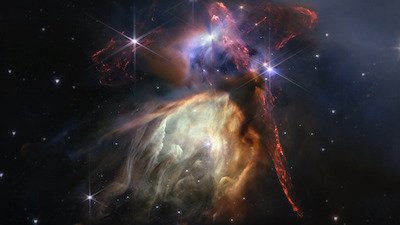
Polaris: A Brief History of the Current North Star
How astronomers track Polaris and other Cepheid stars, issues related to the North Star, and how it relates to cosmology in a stellar evolutionary framework.
Misconceptions About Polaris
In Act III, Scene I of Shakespeare’s play Julius Caesar, Caesar says, “I am constant as the northern star.” This seems to be the source of the common misconception that Polaris (aka the North Star) perpetually remains motionless and steady. To the naked eye, Polaris certainly does seem to remain fixed. Each night in the Northern Hemisphere, the sky appears to spin around Polaris. This is due to the earth’s rotation, which also causes the sun to rise, move across the sky, and set each day. After sunset, that rotation doesn’t stop (or else the sun wouldn’t rise tomorrow morning). Consequently, the stars appear to spin around a point in the sky that we call the north celestial pole.
The north celestial pole is a projection of the earth’s rotation axis onto the sky. Polaris lies within ¾ of a degree of the north celestial pole, so to the naked eye Polaris appears to remain fixed. However, a telescope will reveal that Polaris goes through a tiny circle each sidereal day (a sidereal day is about four minutes shorter than a solar day). This is why we call Polaris the North Star—its location so close to the north celestial pole fixes its position within ¾ degree of true north above the horizon.
For those of you wondering about the Southern Hemisphere, Polaris is not visible in locations more than one degree south of the equator. Nor is the north celestial pole above the horizon south of the equator. But south of the equator the south celestial pole is above the horizon. The south celestial pole is the projection of the earth’s rotation axis onto the sky in the direction opposite the north celestial pole. South of the equator, all the stars appear to spin around the south celestial pole. But since there is no bright star near the south celestial pole, there is no “South Star.”
The star we now call the North Star gained this status only during the Middle Ages.
Another misconception is that Polaris always has been the pole star. It hasn’t been, nor will it always be. Due to the gravitation of the sun and moon, the earth’s rotation axis undergoes precession of the equinoxes. Precession of the equinoxes causes the celestial poles to move along large circles in the sky. This motion is very slow, taking 25,900 years to complete one cycle. Hence, over time Polaris and other stars are at varying distances from the north celestial pole, and there will be different pole stars. At the time of the conventional date of construction of the Great Pyramid of Giza, the pole star was Thuban, the brightest star in the Constellation Draco (Thuban is 25 degrees away from the north celestial pole now). But at many times in the past there was not any noticeable star close enough the north celestial pole to qualify as “the North Star.” Indeed, the star we now call the North Star gained this status only during the Middle Ages (hence Shakespeare’s use during the time of Julius Caesar is an example of an anachronism).
This brings up another pole star misconception. Many people think that the North Star is the brightest star in the sky, so they are surprised when Polaris is pointed out to them, and they readily see that there are brighter stars. Vega, the fifth brightest star in the sky, is a case in point. In about 12,000 years, precession of the equinoxes will bring Vega within four degrees of the north celestial pole. That would will make Vega a pole star of note.
Polaris is a variable star, meaning that its brightness changes.
Yet another misconception is that Polaris has constant brightness. Polaris is a variable star, meaning that its brightness changes. More specifically, Polaris is a Cepheid variable, an important class of variable stars. Cepheid variables are giant and supergiant stars that vary with regular periods anywhere from a few days to about two months. This regular change in brightness is caused by pulsations, as Cepheids alternately expand and contract. A Cepheid’s changing surface area, along with a slight change in temperature throughout its pulsation cycle, results in the regular change in brightness.
The Significance of Polaris (Other Than Being the North Star)
Why are Cepheid variables so important? A little more than a century ago, Henrietta Leavitt discovered that the intrinsic average brightness of a Cepheid is correlated with its period, with the longest period Cepheids having the greatest average brightness. The Leavitt law, as this period-luminosity relation is sometimes called, allows astronomers to measure distances of Cepheid variables. An astronomer collects enough data on a Cepheid so that its period can be determined. Knowing the period, the Leavitt law reveals how intrinsically bright the Cepheid variable is on average. The maximum and minimum observed brightness gives the average observed brightness. Comparing this observed average brightness to its now known intrinsic average brightness allows computation of the Cepheid’s distance. Since some Cepheid variables are supergiant stars, we can see them at tremendous distances, even in other galaxies. Therefore, Cepheid variables reveal the distances of some galaxies. Consequently, Cepheid variables are an important step in finding galaxy distances and in establishing cosmologies.
An additional problem is that Polaris’ proximity to the north celestial pole makes it difficult for some ground-based telescopes to point at Polaris.
It is Polaris’ status as a Cepheid variable that led to its mention in a recent news account. To properly calibrate the Leavitt law, it is essential that we directly measure the distance of a few Cepheids. Cepheids are relatively rare stars, so there aren’t any that are very close to earth. Until three decades ago, no Cepheids were close enough to directly measure their distances by trigonometric parallax, the apparent annual shift in position that a star undergoes as the earth orbits the sun each year. This situation changed with the launch of the HIPPARCOS satellite. Polaris is the closest Cepheid, so it was a high priority for parallax measurement. HIPPARCOS measured the Polaris’ parallax to be 0.00754 ± 0.00011 arcseconds, corresponding to Polaris being 433 light years away. However, some astronomers consider this to be the upper limit to the distance and think that Polaris may be as much as one hundred light years closer than that.
The Gaia mission, which has superseded HIPPARCOS, could have improved upon this distance from parallax measurements, but Polaris is too bright for the Gaia spacecraft to measure. Polaris’ relative brightness is a problem for many ground-based telescopes—it is too bright for many of the sensitive instruments used on telescopes to detect. An additional problem is that Polaris’ proximity to the north celestial pole makes it difficult for some ground-based telescopes to point at Polaris. The way that some telescopes are mounted, it isn’t possible to point the telescope within a few degrees of the north celestial pole (I have done research with two telescopes that suffered this limitation).
Why do many astronomers think that the HIPPARCOS parallax measurement of Polaris is in error and that Polaris is much closer than its measured parallax would allow? Astronomers think that they understand how Cepheid variables work to the extent that they can accurately model Cepheids. When this modeling is applied to Polaris, it results in an intrinsic brightness for Polaris, which, when compared to its observed brightness, yields a distance. This theoretical distance is 323 light years, one-hundred light years closer than the distance from trigonometric parallax. The theory must be right, so the measured distance must be wrong. Or is it?
Such a change in brightness on such a short timescale isn’t possible according to stellar evolution models.
Polaris has some odd properties for a Cepheid. For one thing, the amplitude of variability is rather low. A century ago, Polaris varied by a little more than a 10%, a rather modest amplitude for a Cepheid. But since then the amplitude has decreased to less than 5%. Reportedly, the amplitude is increasing again. If so, this would make Polaris unique, because a reversal toward increasing amplitude has not been seen in any other Cepheid. And for decades the four-day period of Polaris has been decreasing by 4.5 seconds per year. Some astronomers think that this data is attributed to evolution of Polaris, but they can’t agree on how to interpret this. Modern measurements of Polaris’ brightness are 250% brighter than that recorded by Ptolemy 19 centuries ago. Such a change in brightness on such a short timescale isn’t possible according to stellar evolution models.
Polaris and Stellar Evolution
It is into this thicket that two astronomers recently waded. They discussed the history of our understanding of Polaris and the implications of models applied to it. Part of the constraint on the models comes from Polaris being part of trinary star system. In 1779, William Herschel discovered that Polaris is a visual binary, with a second star, Polaris B, in a wide orbit around the brighter star, Polaris A. Then in 1929 astronomers discovered that Polaris A is a spectroscopic binary, where the two stars are not visible individually, but the periodic Doppler shift in the spectrum reveals the presence of the second star. The Cepheid variable dominates the light of this system, so when we speak of Polaris, we mean this star (Polaris Aa), the brightest member of this three-star system (the close companion of Polaris Aa is Polaris Ab).
It is possible with binary stars to find the masses of the stars involved, but there is some ambiguity. As for the closely orbiting pair, the ambiguity comes from not knowing the orbital inclination (the angle that the orbital plane makes with the plane of the sky). The ambiguity in the mass of Polaris Aa largely comes from supposed uncertainty in the distance. The direct measurement of the distance gives a different mass from the mass predicted from stellar evolution models, hence the reason for the closer distance. Furthermore, the stellar evolution models produce ages for the stars that don’t seem to match. Polaris B turns out to be significantly older than Polaris A, but binary stars are supposed to be the same age. The authors of the paper had a solution to this problem: perhaps Polaris Aa originally was an even closer binary star that merged into a single star sometime in the past. They admit that this is highly improbable, but they saw no other solution.
It’s been said in cosmology that one should never let data get in the way of a good model.
Or did they? Here is a wonderful quote from their paper: “On the other hand, perhaps our models are just wrong.” I agree. It’s been said in cosmology that one should never let data get in the way of a good model. It seems that that attitude is slipping more and more into astronomy. As an observational astronomer, I’ve always thought that what we observe takes precedent over the theoretical. Earlier I mentioned that Polaris A is too bright for Gaia to get a good parallax. However, Polaris B is not too bright, and so Gaia has measured its parallax and hence its distance. That distance is 445 light years, consistent with the 433 light years that HIPPARCOS had obtained. Considering that Gaia has ten times the precision of HIPPARCOS, that amounts to confirmation of the earlier determined distance. When in doubt, go with the data, not the theoretical expectations. This conundrum about Polaris probably indicates that the evolutionary models used to interpret Polaris (and, by extension, many other stars) are wrong.

Answers in Genesis is an apologetics ministry, dedicated to helping Christians defend their faith and proclaim the good news of Jesus Christ.
- Customer Service 800.778.3390
- Available Monday–Friday | 9 AM–5 PM ET
- © 2026 Answers in Genesis



